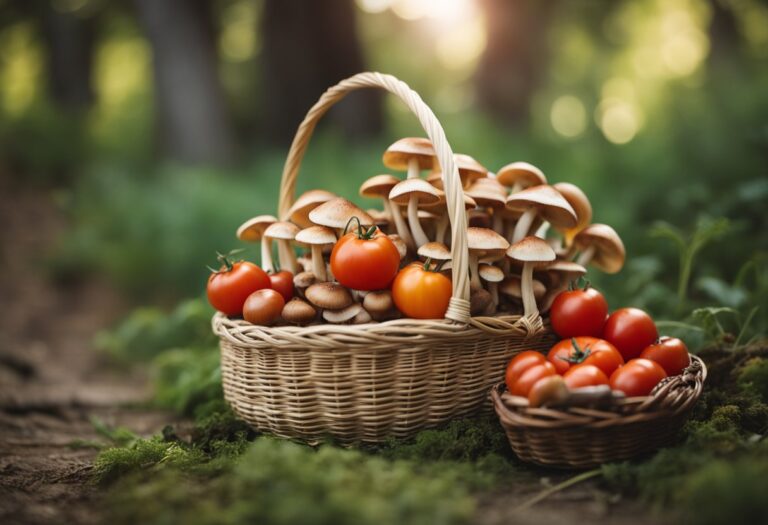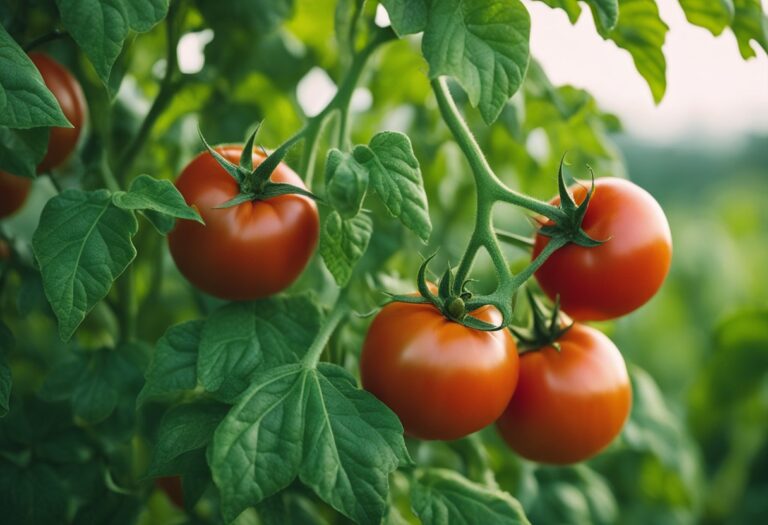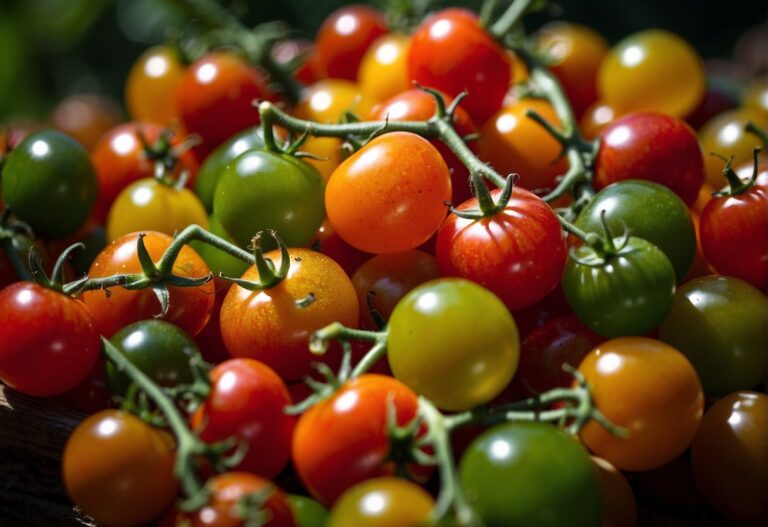Golden Jubilee Tomato: Characteristics and Growing Tips
If you’re looking for a tomato variety that’s both beautiful and delicious, look no further than the Golden Jubilee tomato.
This heirloom tomato has been around since the 1940s and is still a popular choice among gardeners and chefs alike. Its bright golden-orange color and sweet, mild flavor make it a standout in any dish.

Understanding the Golden Jubilee Tomato is important if you want to grow it yourself. This tomato typically grows into a rounded globe shape, with thick outer walls and a solid, meaty interior.
It’s a monochrome fruit, meaning it’s typically all one shade of color. Golden Jubilee tomatoes are known for their low acidity, making them a great choice for tomato juice and other recipes that call for a milder flavor.
Key Takeaways
- The Golden Jubilee tomato is an heirloom variety with a bright golden-orange color and a sweet, mild flavor.
- When growing Golden Jubilee tomatoes, it’s important to understand their shape, color, and low acidity.
- These tomatoes are great for making tomato juice and other recipes that call for a milder flavor.
Understanding the Golden Jubilee Tomato

If you are looking for a tomato variety that is both flavorful and visually appealing, then the Golden Jubilee tomato may be just what you need.
This heirloom tomato is a favorite among gardeners and chefs alike, thanks to its sweet, mild flavor and bright golden color. In this section, we will explore the history and characteristics of this unique tomato.
History and Origin
The Golden Jubilee tomato was first introduced in the United States in the early 1940s. It is believed to be a cross between the Sunrise Bumblebee and the Amana Orange tomato varieties. The tomato was named in honor of Queen Elizabeth II’s Golden Jubilee in 1952.
Characteristics
The Golden Jubilee tomato is a large beefsteak tomato that typically weighs between 8 and 12 ounces. Its skin is smooth and glossy, and its flesh is thick and juicy.
The tomato is known for its rich, sweet flavor and is often used in salads, sandwiches, and sauces. One of the reasons that the Golden Jubilee tomato is so popular is that it is low in acidity, making it a great choice for those who have trouble digesting acidic foods.
Here are some additional characteristics of the Golden Jubilee tomato:
- Size: The diameter of these fruits can range in size from 2.5 to 3 inches. They average about six to twelve ounces in weight.
- Shape: The Golden Jubilee tomato typically grows into a rounded globe shape. Its thick outer walls give the fruit its sturdy and smooth spherical look.
- Color: As the name suggests, the Golden Jubilee tomato is a bright golden color. This makes it a great choice for adding color to salads and other dishes.
In summary, the Golden Jubilee tomato is a unique and flavorful tomato variety that is sure to impress.
Its rich, sweet flavor and bright golden color make it a favorite among gardeners and chefs alike. Whether you are looking to add color to your salads or create a delicious tomato sauce, the Golden Jubilee tomato is a great choice.
Cultivation Techniques

Planting Guidelines
To grow Golden Jubilee tomatoes, you need to start with healthy and viable seeds. You can either purchase them from a reputable seed supplier or save them from a previous harvest.
Plant the seeds indoors 4 to 6 weeks before the last frost date in your area. Once the seedlings have grown to about 6 inches tall, transplant them into the garden, spacing them 18 to 36 inches apart.
Soil and Fertilization
Golden Jubilee tomatoes thrive in well-draining soil that is rich in nutrients. Before planting, prepare the soil by adding organic matter such as compost or aged manure.
This will help improve soil fertility and structure. Fertilize the plants every 3 to 4 weeks with a balanced fertilizer that contains equal amounts of nitrogen, phosphorus, and potassium.
Watering and Sunlight Needs
Golden Jubilee tomatoes require consistent moisture to produce healthy fruit. Water the plants deeply once a week or more often during hot and dry weather.
It is important to avoid getting water on the leaves as this can promote the growth of fungal diseases. Golden Jubilee tomatoes also need full sun to thrive. Make sure to plant them in an area that receives at least 6 to 8 hours of direct sunlight per day.
Common Pests and Diseases
Golden Jubilee tomatoes are susceptible to a variety of pests and diseases, including aphids, whiteflies, and tomato hornworms. To prevent these pests, keep the garden clean and free of debris.
You can also use natural insecticides such as neem oil or insecticidal soap. Some common diseases that affect Golden Jubilee tomatoes include early blight, late blight, and verticillium wilt. To prevent these diseases, avoid overhead watering and overcrowding of plants.
Harvesting and Storage
Harvesting and storing Golden Jubilee tomatoes is easy. In this section, you’ll learn when to harvest, how to harvest, and storage tips to keep your tomatoes fresh for longer.
When to Harvest
Golden Jubilee tomatoes are ready for harvesting about 78 days after planting. You’ll know they’re ready when they’ve reached a bright golden yellow and have a slight give when squeezed.
You can also tell they’re ripe by their sweet aroma. If you’re not sure, you can perform a simple test by gently tugging on the tomato. If it comes off easily, it’s ready for harvesting.
How to Harvest
When harvesting Golden Jubilee tomatoes, use a sharp knife or pruning shears to cut the tomato from the vine. Be sure to leave a small portion of the stem attached to the tomato, as this will help it stay fresh for longer.
Avoid pulling the tomato off the vine, as this can damage the plant and reduce future yields. You can pick them one by one or choose to pull off entire vines to help them keep longer.
Storage Tips
After harvesting, store Golden Jubilee tomatoes indoors and at room temperature. You should avoid placing them in the refrigerator as temperatures below 55 degrees F will do more harm than good to your tomatoes.
For the best flavor, eat your tomatoes within 7 days of picking them. If you have too many tomatoes to eat within a week, you can freeze them by blanching them in boiling water for a few minutes, then cooling them in ice water, peeling, and placing them in a freezer bag. Alternatively, you can also can them using a pressure canner.
Culinary Uses
Golden Jubilee tomatoes are a versatile ingredient that can be used in a variety of ways. Here are some ideas for using them in your cooking.
Fresh Consumption
Golden Jubilee tomatoes are delicious eaten fresh, sliced and added to salads, sandwiches, or eaten as a snack. Their vibrant golden color adds a pop of color to any dish.
They have a sweet, mild flavor that is less acidic than other tomato varieties, making them a great choice for those who find traditional tomatoes too tart.
Cooking Recipes
Golden Jubilee tomatoes are also great for cooking. They can be used in a wide range of recipes, including sauces, soups, and stews. Their sweet, mild flavor adds depth and complexity to dishes without overpowering other flavors.
Here are some recipes to try:
- Golden Tomato Sauce: Simmer chopped Golden Jubilee tomatoes with garlic, onion, and olive oil for a simple and delicious sauce that can be used on pasta, pizza, or as a dipping sauce for bread.
- Tomato and Basil Soup: Combine chopped Golden Jubilee tomatoes with chicken or vegetable broth, garlic, onion, and fresh basil for a comforting and flavorful soup.
- Roasted Golden Jubilee Tomatoes: Cut Golden Jubilee tomatoes in half and place them cut-side up on a baking sheet. Drizzle with olive oil, sprinkle with salt and pepper, and roast in the oven until tender and caramelized. Serve as a side dish or use as a topping for pizza or pasta.
Overall, Golden Jubilee tomatoes are a tasty and versatile ingredient that can be used in a variety of ways in your cooking.
Health Benefits
Golden Jubilee tomatoes are not only delicious but also highly nutritious. Here are some of the health benefits you can get from consuming this tomato variety:
- Rich in Vitamins: Golden Jubilee tomatoes are a great source of vitamins A, C, and K. Vitamin A is essential for maintaining healthy eyesight, while vitamin C helps boost your immune system. Vitamin K is important for blood clotting and bone health.
- High in Fiber: These tomatoes are also high in fiber, which can help improve your digestion and keep you feeling full for longer periods of time.
- Antioxidants: Golden Jubilee tomatoes contain antioxidants such as beta-carotene and lycopene. These compounds can help protect your cells from damage caused by free radicals, which can lead to chronic diseases such as cancer and heart disease.
Incorporating Golden Jubilee tomatoes into your diet can help you reap these health benefits while also enjoying their sweet and juicy flavor. Try adding them to your salads, sandwiches, or sauces for a nutritious and tasty meal.
Frequently Asked Questions
What is the flavor profile of Golden Jubilee tomatoes?
Golden Jubilee tomatoes have a mild flavor with low acidity, making them great for juice. They have a bright, golden-orange color and meaty, thick walls. The fruits are solid with few seeds, which makes them perfect for slicing and adding to salads.
What is the typical height for a Golden Jubilee tomato plant?
Golden Jubilee tomato plants can grow up to 6 feet tall, depending on the growing conditions.
They are indeterminate growers, which means they continue to grow and produce fruit throughout the growing season. You can prune them to control their height and promote better fruit production.
Are Golden Jubilee tomatoes determinate or indeterminate growers?
Golden Jubilee tomatoes are indeterminate growers, which means they continue to grow and produce fruit throughout the growing season. They can grow up to 6 feet tall and require support to prevent them from falling over.
What are the best care practices for a Golden Jubilee tomato plant?
To grow healthy Golden Jubilee tomato plants, you should provide them with full sun exposure, well-draining soil, and regular watering. You can also fertilize them every 2-3 weeks with a balanced fertilizer. Prune the plants to promote better fruit production and remove any diseased or damaged leaves.
Can Golden Jubilee tomatoes be used to make a golden tomato sauce?
Yes, Golden Jubilee tomatoes can be used to make a golden tomato sauce. They have a bright, golden-orange color that adds a unique flavor and appearance to the sauce. You can also use them in salsa, salads, and other dishes that require fresh tomatoes.
How do Golden Jubilee tomatoes compare to other orange varieties like Sungold?
Golden Jubilee tomatoes are larger than Sungold tomatoes and have a mild flavor with low acidity. Sungold tomatoes, on the other hand, have a sweet and tangy flavor and are smaller in size. Both varieties are great for snacking and adding to salads.



